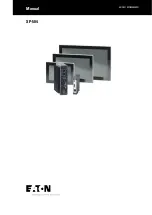
ENCLOSURES
-
X
-
English
CA
2415
1100.
fm
ID
M
Connections
The battery charger is equipped with a power cord that
has a plug with two single polar red and black wires for
DC output.
The control board has a 6-way connector for
connection to the diagnostic relays.
The movable connector is MOLEX brand of the MINI-
FIT-JR family with female contacts.
Voltage changer
The power cord terminates on a terminal board where
three rated voltage possibilities are indicated: factory
connections are for a 230V plug, for the RBP24M20-0
model, and for a 110V plug for the RBP24M20-0-110
model.
Turning on
– Before connecting the battery make sure it is a 24V
rated battery
– Before connecting to the mains make sure that the
voltage level matches the settings on the voltage
changer on the terminal board.
– Connect the red and black wires to the battery.
Pay attention to the polarity red = positive, black
= negative
At this point the yellow led turns on (BATTERY
CONNECTED).
– Connect the mains, wait a few moments until the red
led turns on (SUPPLY): the battery charger is working.
FUNCTIONAL DESCRIPTION (SOFTWARE SWE01B)
Note: the response time of the board is rather slow
(a few seconds), to avoid false interventions due to
interferences. Keep in mind during inspection.
Limit calibration
The trimmer for fine calibration of the voltage limit is to
vary (approxi-0,1V/el) the voltage limit values
including charge end and max. voltage. The board is
furnished calibrated to 30.0V.
Cycle description
The beginning of the cycle occurs when the mains is
connected. It is assumed that the battery is
permanently connected. All the leds turn on for 4
seconds ensuring that none of them are broken and
that the board is efficient. After 5 sec. The red
“SUPPLY” led turns on and the “initial charge” phase
starts in which the board continuously controls battery
voltage. When the limit is reached (typically 2,5V/el),
the “final charge time” is counted and the “BATTERY
CHARGED” led blinks. At the end of this time the
“BATTERY CHARGED” led turns on and the battery
charger turns off because charging has terminated.
During a normal cycle, the “Fail” relay is never activated.
Equalization
If the equalization activation bridge is present
(BRIDGE 3), once charging has terminated an
equalization cycle starts characterised by the battery
charger turning on for 2 minutes every 12 minutes for
a maximum of 72 times.
If power is disconnected during this time the cycle is
interrupted and a new charge cycle starts when power
is restored.
Dimming
For the first 30 minutes from turning on, even if the
battery voltage rises over the final charge limit, the
board does not move to final charge in order to permit
partially sulphated batteries to stabilise.
Charge phase indication
The “BATTERY CHARGED” led indicates the charge
phase:
– Off = initial charge in progress.
– Blinking = final charge in progress.
– On = charge correctly terminated.
If the charge terminates due to anomaly, the led remains
off even if the final charge phase was reached.
Charge diagnosis
If an anomaly is detected the battery charger turns off
and the “BATTERY CHARGED” led does not turn on
at the end of the cycle. The “SUPPLY/DIAGNO” led
blinks to indicate which anomaly was detected, and the
“Fail” relay is activated for remote signalling. This
condition continues until the mains power is
disconnected: the next time the mains power is
connected the board cancels all the alarms.
Foreseen anomalies are:
1)
Max. charge time passed (14 hours from charge
start).
2)
Excessive battery voltage during charging. (>2,85
V/el)
3)
Battery voltage too low or too high at start. (<1,4 V/
el, >3,0 V/el)
EDN GROUP s.r.l. - INDUSTRIAL ENVIROMENT



































